 |
Close
window to return
|
Issue 2, July 1998, pp.4-5&14.
Health:
who you are or where you live?
Richard Mitchell, Simon Gleave, Kevin Lynch, Heather Joshi, Dick
Wiggins and Mel Bartley
Introduction
Our project is concerned with the relationship between an individual's
health and their area of residence. It is a well- established fact that
people who live in different areas experience different levels of ill-health.
For example, we find a higher rate of limiting long-term illness in Newcastle-upon-Tyne
(about 14%) than we do in Salisbury (about 9%). However, we also know
that the chances of reporting a limiting long-term illness are strongly
related to an individual's socio-economic and demographic characteristics.
For example, older people, working class people and people in hazardous
jobs all report relatively more illness. Most areas differ with respect
to the types of people who live in them. There are relatively more 'at
risk' people in Newcastle than Salisbury: therefore the amount of illness
reported in an area will be very strongly related to its social and demographic
profile. We call this social and demographic profile of an area its 'composition'.
Some researchers have also suggested that there may be something about
a particular area that influences an individual's health over and above
their own characteristics. This might include the level of deprivation
in the neighbourhood, the availability and quality of services and shops
or the physical climate. These kinds of area characteristics are collectively
known as its 'context'.
Our main research question is therefore very simple: are geographical
inequalities in health and illness just a reflection of socio-economic
differences among their inhabitants (composition) or do places add their
own contribution to patterns of health variation (context)?
Attempts to find an effect of area context on mortality and morbidity
at a national (England and Wales) level have already been carried out.(1,2)
Working with electoral wards, they concluded that individual characteristics
(composition) were sufficient to account for health differences between
wards when the 'context' was defined by indicators of deprivation in the
local population. Interestingly however, a north/south divide remained
inexplicable by composition alone. The advance offered by this project
is to adopt the technique called Multi-Level Modelling (MLM). MLM allows
us to look at the relationship between each individual and their area
of residence and it allows us to explore more sophisticated measures of
area context.
Findings so far
To investigate the composition or context question, we extracted a sample
of men who had a potentially full working history between 1971 and 1981,
from the ONS Longitudinal Study (69,352 individuals living in England
and Wales). A number of individual characteristics were used as explanatory
variables (see Table 1) and the reporting of a 'limiting long-term illness'
in 1991 was the health outcome. We used just one variable to model area
context, a classification developed by ONS from Census data. The classification
attempts to describe the character of the Local Authority District in
which an individual lived in 1991 (see Table 2 for a description of the
classification).
There were three modelling stages. First of all, we modelled illness using
just age as an explanatory variable. Next, we added the rest of the individual
characteristics and finally we added the ONS area classification. By estimating
models for each stage, we could observe whether a district has an excess
of poor health or good health.
Table 1: Individual level variables
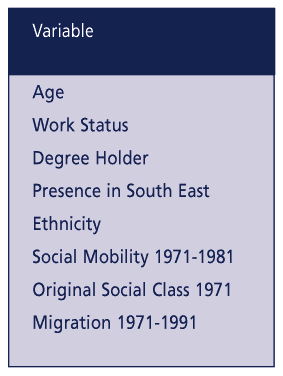
Table 2: District
level variables
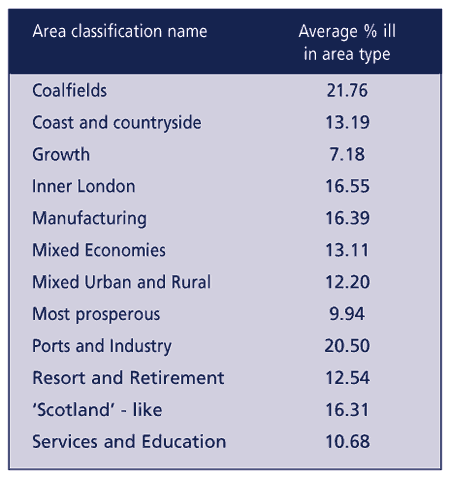
Not surprisingly,
we found a clear relationship between increasing age and probability of
reporting a limiting long-term illness. But there were still health differences
between areas not accounted for by the age differences between their populations
alone. When we added the rest of the individual level characteristics,
the amount of area difference that we could not explain fell considerably.
It appears that any period of non-employment, having below degree-level
educational attainment, not having lived in the South East of England
and being non-white all significantly increase an individual's chances
of reporting a limiting long-term illness. When we added the ONS classification,
the area variation that we could not explain reduced further.
Figure 1: Limiting long-term illnes in men aged 36-65 by local
authority District (1991)
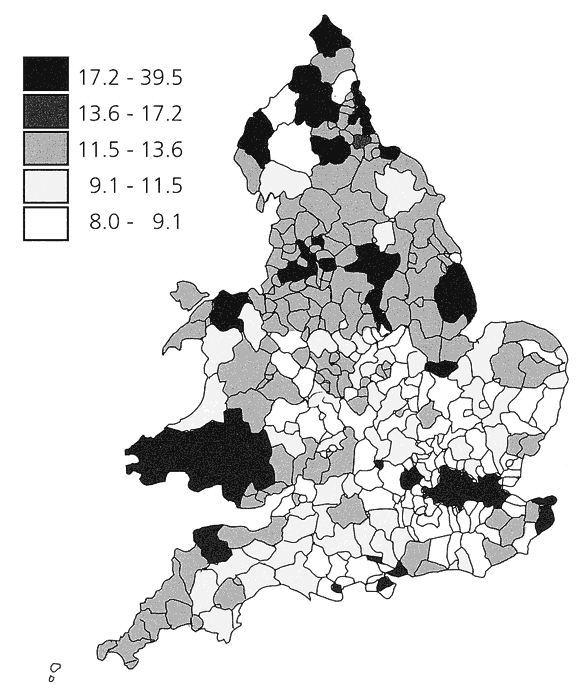
The districts which ONS have called 'prosperous' and 'growth' areas appear
to lower an individual's chances of reporting illness, whereas the districts
which ONS call 'coalfields' and 'ports' appear to increase their chances
of reporting illness, even after we allowed for individual characteristics.
Figure 1 shows that without accounting for composition, areas with high
levels of limiting long- term illness are in men generally found in South
Wales or the North of England (heavily urbanised or ex-industrial areas)
and those with low levels of limiting long-term illness tend to be rural
areas in southern England or prosperous towns surrounded by countryside
such as Newbury. However, once we account for individual characteristics,
many of these areas no longer stand out (see Figure 2 below).
Figure 2: Areas which remain significantly more healthy or less
healthy after adjustment for composition
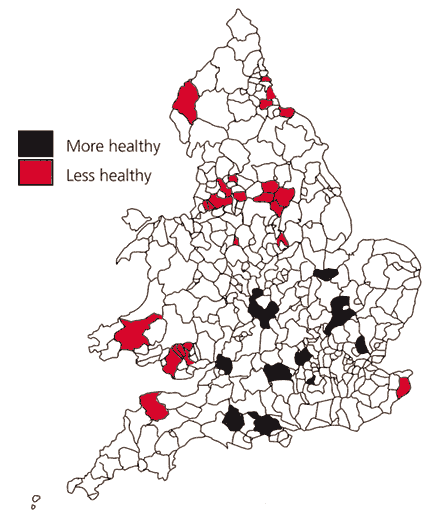
Figure 3 shows that, once we account for area context by using the ONS
classification, just ten districts remain with inexplicably good or bad
health. This tells us that, whilst a lot of the variation in health between
these areas is accounted for by 'composition', a significant portion may
be accounted for by 'context'.
Figure 3: Areas which remain significantly more healthy or less healthy
after we adjust for context using ONS classifications
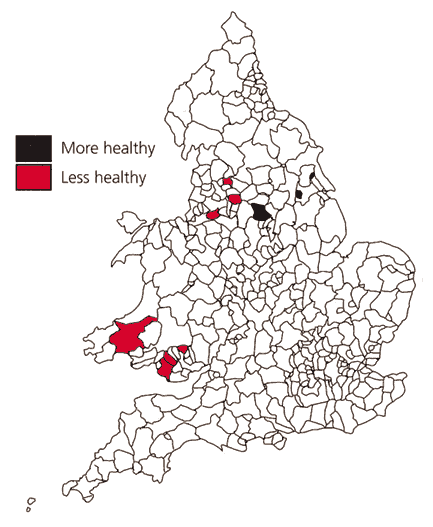
Conclusions
The investigation has shown some interesting results, but it has also
raised a number of questions. Although the ONS classification has worked
quite well, we need to decide what other kinds of information will describe
an area's context and how we are going to represent that information in
the model.
Amongst the next stages in our MLM work will be a model for women and
one which includes electoral wards as well as county districts. In addition
to MLM work, we are exploring measures of de-industrialisation and individual
perceptions of, and interactions with, neighbourhood, using the Health
and Lifestyle Survey (HALS) data. In combination, this work will help
us understand the relationship between individuals and their neighbourhoods
more clearly and allow us to explore more complex measures of an area's
context. We are also using National Child Development Study (NCDS) data
to model an individual's 'investment' in health through time (maintaining
a healthy lifestyle and taking care of oneself for example). The model
will allow for the possibility that this investment behaviour may be influenced
by area of residence.
All these approaches require more work to explore how the boundaries drawn
between areas may influence the results we actually obtain. We are hoping
to move away from using administratively-defined boundaries. By using
custom-designed boundary systems, we have already observed changes in
our detection of area differences.
Policy Implications
Finally, the policy implications of this kind of work require attention.
The area influence on health that we have found so far is small in comparison
to the influence of individual characteristics, yet the government is
stepping up its targeting of health care resources by 'zone'. Although
we have shown that some areas do contain concentrations of needy people,
thus far our research supports the primacy of individual circumstances
in determining adverse health outcomes. We hope our continuing research
will shed more light on how these individual characteristics interact
with their surroundings.
A copy of our working paper' Limiting long-term Illness: A question of where you live or who you are?', which describes the MLM work in full is available from SSRU. Contact telephone number: 0207-4778486; or write to: SSRU, City University, Northampton Square, London, EClV 0HB.
Acknowledgements
This work is based on data provided with the support of the ESRC and JISC
and uses boundary material which is copyright of the Crown and the ED-LINE
Consortium. We gratefully acknowledge the ONS for access to the LS.
References:
1. Sloggett, A. and Joshi, H. (1998) 'Deprivation indicators as predictors
of life events 1981-1992 based on the UK ONS Longitudinal Study' Journal
of Epidemiology and Community Health, 52, 4, 228-233.
2. Sloggett, A. and Joshi, H. (1994) 'Higher mortality in deprived areas:
community or personal disadvantage?' British Medical Journal, 309,
1470-1474.